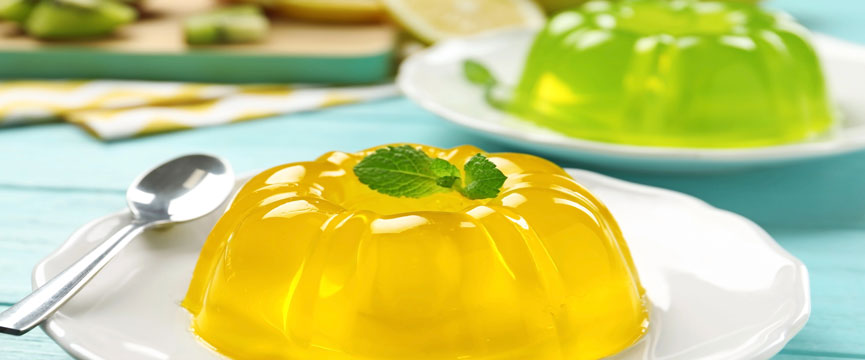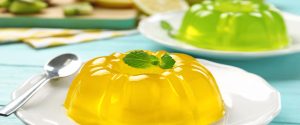
 The world of baking and gastronomy is full of opportunities to experiment with flavors, textures, and presentations. Jelly fruits are a classic ingredient that adds freshness and color to any culinary creation. However, one of the most common challenges is getting the jelly fruits to set quickly without compromising its quality.
The world of baking and gastronomy is full of opportunities to experiment with flavors, textures, and presentations. Jelly fruits are a classic ingredient that adds freshness and color to any culinary creation. However, one of the most common challenges is getting the jelly fruits to set quickly without compromising its quality.

So, in this post, we’ll explore the process of making jelly fruits and the variables that can influence its production time and quality. Stay with us because we’ll be exploring things you might not have known about this delicious ingredient. We will also discover why Lazaya is the preferred supplier of gels and gelatins for professionals.
Table of Contents
The process of making jelly fruits
Jelly fruits are a relatively simple preparation, but it also requires precise timing and knowledge to apply all the necessary ingredients. Let’s look at the basic process below:
Correct ingredients and proportions
The foundation for success in making professional gelatins lies in precise mixing of the ingredients. For a standard liter of jelly, the recommended proportions are:
- Fresh fruits: between 200 and 300 grams.
- Gelatin powder or sheets: 10 to 15 grams, depending on the desired firmness.
- Base liquid: water, fruit juice or both (between 800 and 900 ml).
- Sugar: Between 50 and 100 grams (adjustable according to the fruit’s acidity). Depending on the fruit, sugar may or may not be added.
Hydration of jelly fruits
Hydrating the gelatin is one of the most important steps for quick, even setting. If using powdered gelatin, sprinkle it over a little cold water and let it sit for a few minutes until the liquid is absorbed. If using sheet gelatin, soak it in cold water until it softens.
- Cold hydration: Sprinkle the gelatin over cold liquid (5 times its weight) and let it sit for 5-10 minutes.
- Controlled dissolution: Heat to 50°C or 60°C without boiling to preserve the gelling power.
- Homogeneous integration: the mixture must be made avoiding the incorporation of air.
Preparation of the fruit liquid
Heat the base liquid (water, fruit juice, or a combination of both) in a saucepan. If you want to sweeten it, add the sugar at this point and stir until it’s completely dissolved.
Integration of the jelly fruits
Once the liquid is hot, remove it from the heat and add the hydrated gelatin. Make sure it dissolves completely to prevent lumps from forming.
Add the fruits
Now’s the time to add the fresh fruit or puree. If using fresh fruit, make sure it’s cut into small pieces to facilitate setting.
What variables influence the setting of jelly fruits?
The time it takes for jelly fruits to set can vary depending on several factors. Let’s review the most important ones:
Gelatin concentration
The amount of gelatin used is very important. A higher concentration will allow for faster setting. However, too much can result in a texture that is too rigid.
Temperature
The cooling process is very important to accelerate the setting of the jelly. Once the ingredients are mixed in the mold, we place it in the refrigerator. Some chefs use an ice bath to lower the temperature more quickly before refrigeration. Here are some aspects professionals should consider regarding temperature:
- Mixing temperature: Keep the gelatin between 35°C and 40°C before pouring into the molds.
- Rapid cooling: blast chillers or ice baths can be used.
- Storage temperature: For optimal setting, this temperature should range between 2°C and 4°C.
Concentration of gelatin and bloom
The “bloom” or strength of the gelatin directly influences its gelling capacity. Professionals often use it as follows:
- Gelatine of 180-200 bloom: ideal for firm textures and quick setting.
- Concentration between 1.5% and 2%: provides structure without compromising texture.
- Adjustment according to application: Mousses require less concentration than cut gelatins.
pH and acidity of the medium
The pH of the medium is another factor that influences the speed and quality of setting. The acidity level of the base liquid can affect the gelation process, so highly acidic liquids may require more gelatin to achieve the desired setting. Let’s review some relevant aspects of this factor:
- Optimal pH: for maximum efficiency it should be between 4.0 and 7.0.
- Acidic fruits: require between 10% and 20% more gelatin.
- pH correction: Sodium citrate is used to stabilize the gelatin.
Type of fruit
Keep in mind that some fruits contain enzymes (such as bromelain in pineapple or papain in papaya) that can interfere with gelling. To counteract this, you can cook the fruits lightly before adding them to the mixture.
Advantages of choosing professional-quality jelly fruits
Choosing a quality supplier for jelly fruits is essential to ensure consistent results. These are the main factors professionals consider when choosing jelly fruits:
- Purity and authentic flavor: A quality jelly offers maximum flavor and purity, highlighting the best of each fruit used.
- Perfect texture: A good texture achieves an ideal balance between firmness and softness, allowing creations to have the necessary stability without compromising the tasting experience.
- Versatility: Professionals use gelatins for a wide range of applications, from classic desserts to innovative and avant-garde presentations.
Lazaya jelly fruits and gels: professionals’ favorites
Once we have seen all the aspects that influence the quick-setting of jelly fruits, we can sense the great importance for professionals in choosing quality gelatins to create desserts and dishes that stand out from the competition in Horeca establishments.
In Lazaya Preserved Fruits we have been carrying out the entire jelly fruit production process for over 80 years . We are also wholesalers of high-quality gels and gelatins for professionals. They often use this product to add color, flavor, and surprising textures to a multitude of desserts, such as cakes, tarts, tartlets, ice cream, etc., among other applications.
If what you are looking for is a professional supplier and scalability to produce your products, we invite you to explore our selection of gels and jellies that perfectly suit your needs. They come in different brix sizes, can be used for baking or spreading, and come in a wide variety of flavors, with or without sugar: neutral, strawberry, orange, apple, lemon, or vanilla. Contact us if you need to clarify any doubts.





